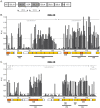VAR2CSA signatures of high Plasmodium falciparum parasitemia in the placenta
- PMID: 23936092
- PMCID: PMC3723727
- DOI: 10.1371/journal.pone.0069753
VAR2CSA signatures of high Plasmodium falciparum parasitemia in the placenta
Abstract
Plasmodium falciparum infected erythrocytes (IE) accumulate in the placenta through the interaction between Duffy-binding like (DBL) domains of parasite-encoded ligand VAR2CSA and chondroitin sulphate-A (CSA) receptor. Polymorphisms in these domains, including DBL2X and DBL3X, may affect their antigenicity or CSA-binding affinity, eventually increasing parasitemia and its adverse effects on pregnancy outcomes. A total of 373 DBL2X and 328 DBL3X sequences were obtained from transcripts of 20 placental isolates infecting Mozambican women, resulting in 176 DBL2X and 191 DBL3X unique sequences at the protein level. Sequence alignments were divided in segments containing combinations of correlated polymorphisms and the association of segment sequences with placental parasite density was tested using Bonferroni corrected regression models, taking into consideration the weight of each sequence in the infection. Three DBL2X and three DBL3X segments contained signatures of high parasite density (P<0.003) that were highly prevalent in the parasite population (49-91%). Identified regions included a flexible loop that contributes to DBL3X-CSA interaction and two DBL3X motifs with evidence of positive natural selection. Limited antibody responses against signatures of high parasite density among malaria-exposed pregnant women could not explain the increased placental parasitemia. These results suggest that a higher binding efficiency to CSA rather than reduced antigenicity might provide a biological advantage to parasites with high parasite density signatures in VAR2CSA. Sequences contributing to high parasitemia may be critical for the functional characterization of VAR2CSA and the development of tools against placental malaria.
Conflict of interest statement
Figures




References
-
- Brown A, Higgins MK (2010) Carbohydrate binding molecules in malaria pathology. Curr Opin Struct Biol 20: 560–566. - PubMed
-
- Mayor A, Bir N, Sawhney R, Singh S, Pattnaik P, et al. (2005) Receptor-binding residues lie in central regions of Duffy-binding-like domains involved in red cell invasion and cytoadherence by malaria parasites. Blood 105: 2557–2563. - PubMed
-
- Menéndez C, Ordi J, Ismail MR, Ventura PJ, Aponte JJ, et al. (2000) The impact of placental malaria on gestational age and birth weight. J Infect Dis 181: 1740–1745. - PubMed
-
- Desai M, ter Kuile FO, Nosten F, McGready R, Asamoa K, et al. (2007) Epidemiology and burden of malaria in pregnancy. Lancet Infect Dis 7: 93–104. - PubMed
Publication types
MeSH terms
Substances
Associated data
- Actions
- Actions
- Actions
- Actions
- Actions
- Actions
- Actions
- Actions
- Actions
- Actions
- Actions
- Actions
- Actions
- Actions
- Actions
- Actions
- Actions
- Actions
- Actions
- Actions
- Actions
- Actions
- Actions
- Actions
- Actions
- Actions
- Actions
- Actions
- Actions
- Actions
- Actions
- Actions
- Actions
- Actions
- Actions
- Actions
- Actions
- Actions
- Actions
- Actions
- Actions
- Actions
- Actions
- Actions
- Actions
- Actions
- Actions
- Actions
- Actions
- Actions
- Actions
- Actions
- Actions
- Actions
- Actions
- Actions
- Actions
- Actions
- Actions
- Actions
- Actions
- Actions
- Actions
- Actions
- Actions
- Actions
- Actions
- Actions
- Actions
- Actions
- Actions
- Actions
- Actions
- Actions
- Actions
- Actions
- Actions
- Actions
- Actions
- Actions
- Actions
- Actions
- Actions
- Actions
- Actions
- Actions
- Actions
- Actions
- Actions
- Actions
- Actions
- Actions
- Actions
- Actions
- Actions
- Actions
- Actions
- Actions
- Actions
- Actions
- Actions
- Actions
- Actions
- Actions
- Actions
- Actions
- Actions
- Actions
- Actions
- Actions
- Actions
- Actions
- Actions
- Actions
- Actions
- Actions
- Actions
- Actions
- Actions
- Actions
- Actions
- Actions
- Actions
- Actions
- Actions
- Actions
- Actions
- Actions
- Actions
- Actions
- Actions
- Actions
- Actions
- Actions
- Actions
- Actions
- Actions
- Actions
- Actions
- Actions
- Actions
- Actions
- Actions
- Actions
- Actions
- Actions
- Actions
- Actions
- Actions
- Actions
- Actions
- Actions
- Actions
- Actions
- Actions
- Actions
- Actions
- Actions
- Actions
- Actions
- Actions
- Actions
- Actions
- Actions
- Actions
- Actions
- Actions
- Actions
- Actions
- Actions
- Actions
- Actions
- Actions
- Actions
- Actions
- Actions
- Actions
- Actions
- Actions
- Actions
- Actions
- Actions
- Actions
- Actions
- Actions
- Actions
- Actions
- Actions
- Actions
- Actions
- Actions
- Actions
- Actions
- Actions
- Actions
- Actions
- Actions
- Actions
- Actions
- Actions
- Actions
- Actions
- Actions
- Actions
- Actions
- Actions
- Actions
- Actions
- Actions
- Actions
- Actions
- Actions
- Actions
- Actions
- Actions
- Actions
- Actions
- Actions
- Actions
- Actions
- Actions
- Actions
- Actions
- Actions
- Actions
- Actions
- Actions
- Actions
- Actions
- Actions
- Actions
- Actions
- Actions
- Actions
- Actions
- Actions
- Actions
- Actions
- Actions
- Actions
LinkOut - more resources
Full Text Sources
Other Literature Sources

